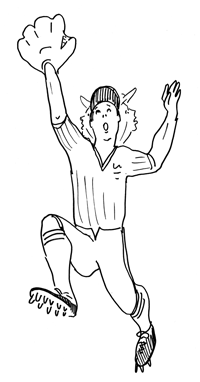STRANGE BUT TRUE- Pop-ups: Why that baseball goes 'to-and-fro'

DRAWING BY DEBORAH DERR McCLINTOCK
Q. Why have sports scientists begun referring to baseball's "paradoxical pop-ups"?–M. Ramirez
A. Because these seemingly routine infield fly balls that go almost vertically upward can take such bizarre trajectories as to befuddle even veteran fielders, say New Scientist magazine and The American Journal of Physics.
A normally-struck baseball follows a predictable parabolic path. But a pop-up's backspin due to hitting the top of the bat creates a "Magnus force" like a curve ball, with a rotating sheath of air around it. When physicists Alan Nathan and Terry Bahill ran a computer simulation to calculate a pop-up's trajectory, they found the sharply backspinning ball can at first fly at a steep angle before the backspin forces its path to vertical, then eventually sends it looping back on itself. Once it reaches its apex and begins to drop, the spinning ball crosses back over its upward path. So the fielder may need to do a little "to-and-fro dance" under the ball to make the catch.
Q. Cellphones are everywhere these days, handy and easy to use– at times too easy. How are modern cellphone technologies and services assisting subscribers in making subterfuge calls or in averting embarrassing ones?–A. Baldwin
A. For $34, a Russian company will assist an adulterer in lying to a spouse about his or her whereabouts with a coverup call, says Tyler Cowen in Discover Your Inner Economist. A service named Sound Cover gives the caller the choice of adding background sound, such as mimicking traffic, construction noises, the circus, a dentist's drill.
And don't we all know people who get drunk and in a sentimental or loquacious mood make calls they shouldn't. In one survey of mobile phone users, 95% had done this, mostly to ex-partners (30%), to current partners (19%) or to others such as bosses (36%). To alleviate this drink-and- dial problem, an Australian phone company started offering customers blocked "blacklist" numbers, which they select before going out. In Japan, a mobile phone with a breathalyzer will check to see if someone is really fit to drive home, or even to make a phone call. "If a bus driver fails the test, his location is sent immediately to his boss by GPS."
Q. Oh, no! The elevator cable snaps, and the backup safety system fails and down, down, down you go. How do you optimize your chances of surviving? Would it help to leap up just before the cab collides at the shaft's bottom?–K. Yamguchi
A. Better to drop to the floor and spread out, preferably on your back, which is possible now since there is some drag on the cab from the guide rails, says Jearl Walker in The Flying Circus of Physics. The idea is to spread the force you are about to experience over as much body surface area as possible. Standing is ill advised, since under such a collision your ankles will collapse and your body's trunk will crash hard to the floor. Jumping up at the last moment (surely this is impossible to time from an enclosed cab) may be the worst thing you can try since this will only slow you slightly and "if the cab ricochets from the bottom of the shaft you'll be traveling downward as the floor of the cab is traveling upward, and shortly later... Well, no need for the gory details."
In a tragic incident on July 28, 1945, a U.S. Army B-25 bomber crashed into the 78th and 79th floors of the Empire State Building, killing three in the plane and 10 workers inside the building. When an injured elevator operator was being taken down for medical help, the cable snapped and the elevator cab fell to the subbasement. Rescuers found the two women occupants alive though badly injured. The safety devices had apparently slowed their descent sufficiently to diminish the crash. "There is no report on what the women did during the fall, but because of fear and the jostling, I doubt that they remained standing."
~
Send strange questions to brothers Bill and Rich at [email protected].
#